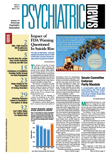Christopher Thomas, M.D., is using state-of-the-art videoconferencing facilities to provide psychiatric services to students at Ball High School in Galveston from his office at the University of Texas Medical Branch at Galveston (UTMB).
Funded by a $500,000 grant from the Robert Wood Johnson Foundation and matching grants from six Galveston and Houston foundations, UTMB began the project last summer, setting up a video-conferencing work station at a nonprofit, primary care clinic at Ball High School.
Thomas and students see and speak to each other through flat-panel televisions and related equipment in both the school and his office. The funding will also allow the university to install these stations in clinics at three Galveston middle schools.
“The thing I am most excited about with this program is the opportunity to provide better access to mental health services to youth,” Thomas, a professor of psychiatry and behavioral sciences at UTMB, told Psychiatric News. He believes this approach can do much to help address the shortage of child and adolescent psychiatrists, particularly in rural and impoverished areas, and to make these services more accessible to many others who need them.
The program allows students to remain at school to receive counseling services and allows parents to participate there as well, which many prefer to having to pick up their children at school and taken them to a doctor's office or clinic.
Thomas also noted that other students may be less likely to notice when their peers are receiving such services if they're provided on site rather than forcing children to leave school premises, thus increasing privacy and reducing potential stigma. In addition, providing these services at school makes it less likely that referrals for treatment will “fall between the cracks” as often happens after a child is sent from school to another location for psychiatric evaluation.
Thomas said the youngsters he has dealt with are often more receptive to the teleconferencing approach than are some physicians who are not used to dealing with patients remotely. “Many of the children are fascinated to see themselves on the monitor,” he said. “It's a good opportunity to have them talk about themselves and tell me what they see.”
Thomas also believes that telemedicine can increase access to young patients in nonschool settings. He envisions using it to reach youth in detention or correctional facilities and said he would like to see telepsychiatry integrated with primary care by making it available through community health clinics and pediatric practices.
Thomas has already used the technology to conduct in-service sessions for teachers and counselors who dealt with students who were affected by hurricanes Katrina and Rita and began in 1999 to provide psychiatric services for victims of domestic violence that involved school outreach and community education. He said he has found the approach to be quite helpful in serving this population.
“Research indicated that victims of violence have difficulty forming a therapeutic relationship with therapists of the same sex as their abusers,” he explained. “I now think that the use of teleconference facilitated my forming a therapeutic alliance with the patients, as it formed a clear physical separation.”
The University of Texas Health Science Center in Houston has also used telemedicine to provide pediatric and specialty consultation through school nurses in the Rio Grande Valley.
Telepsychiatry does pose some logistical limitations, he noted. “I cannot physically interact in the play assessment or play therapy, but I can still have a child talk about their play and use the presenter [an adult who is present during at least part of many sessions to help make appointments and escort or otherwise assist children and parents during sessions] or have the child pretend to take my role in the play, which can be very revealing,” he said.
In addition, technical glitches sometimes arise that can hinder access, Thomas noted, due to interference caused by computer firewalls or other programming issues. He once wound up conducting sessions by telephone, rather than on screen after a backhoe cut through his office's dedicated T1 communications line. He said that his young patients were quite disappointed that they couldn't appear that day “on television.”
Thomas said that planning for the provision of telemedicine services must involve detailing all aspects of the service delivery system, especially when multiple agencies are involved. “The protocol makes clear the sequence of events in providing services and everyone's role in delivering them,” he explained. “Regular review of service delivery is also important, and the protocol provides a framework to carry out quality assurance.”
More information about UTMB's use of telemedicine is posted at<www.utmb.edu/telehealth>.▪
